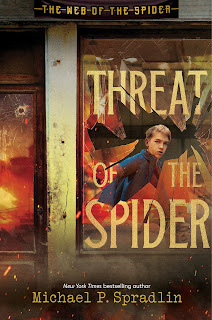Interview with Michael P. Spradlin, Author of Threat of the Spider

Welcome to Smack Dab,Michael. Please tell us about Threat of the Spider.
Threatof the Spider is the second book in the Web of the Spider series, following onthe heels of The Rise of the Spider which came out last fall. The series is setin a small town in Germany and follows the lives of several young people duringthe 1930s and Hitler’s rise to power.
How did you come to writea historical fiction series for young readers focusing on Nazi Germany?
Ihad interest in doing a book on the Edelweiss Pirates who were a real group ofchildren that challenged the Nazi regime during the war. After some back andforth with my editor when went back even further looking for the seeds ofyouthful dissent. It was important to me that readers realize that not everyoneGerman citizen supported Hitler or the Nazi party. Especially at the beginning.
Ansel’s “UnassailableFacts of Life” are such a memorable part of his character. How did you developthis quirk? Do any of these sayings have special meaning to you?
I don’t know where the idea came from, but once I tried a couple of‘facts’ (which as we know are no facts at all) they seemed to fit hispersonality like a glove. They are one of my favorite parts of his characterand I laugh at his willingness to interject this ‘wisdom’ into any situation. Ithink one of my favorites is #41When the owls cometo the mice picnic, they are not there for the sack races.
Your author's notementions visiting Heroldsberg and Nuremberg for research. How did physicallybeing in these locations shape the story?
Ithad a tremendous impact on the book. For the most part the historical fictionI’ve written takes place in a world that no longer exists. Heroldsberg sufferedlittle during the war in the way of damage from bombing or fighting. And withNuremberg the medieval city was rebuilt after the war to how it was. So it wasa chance to see places as the characters did. And it was invaluable.
How did you balancecreating fictional characters like Ansel with incorporating historical figureslike Heinrich Himmler?
I’mnutty about including real historical figures in my novels. I just think itadds so much gravitas to the story. Plus it’s fun to play puppet master withsome of these figures and gain insight to what they might have thought or felt.
What challenges did youface in writing about such a dark historical period for a middle-gradeaudience?
Thesehave been challenging books no doubt. These are complicated historical,political, religious and socio-economic themes at work here. Trying to condensethat down in an interesting ‘non-info dump’ way hasn’t been easy. Luckily smartcharacters help you figure it out.
The Hitler Youth plays asignificant role in the story. What sources did you use to understand how thisorganization recruited and influenced young people?
Thereare a ton of sources. YouTube video interviews with Hitler Youth members, ahost of memoirs and histories. The Hitler Youth is to me, one of the mostfascinating parts of the Nazi rise to power. This complete and total indoctrinationof a country’s youth is just mind boggling.
The book shows howeveryday citizens responded differently to the rise of Nazism. What message doyou hope young readers take away about standing up against injustice?
Standingup against injustice is hard. Being the one that says, ‘this far, no further,’is always rife with conflict. I want young readers to realize that freedom isprecious. It’s a garden that all of us need to water and nurture. Becausefreedoms can be taken away.
The book's title "Threatof the Spider" has multiple potential meanings. Could you explain itssignificance in relation to the story?
Thewhole idea for the series was that Spider is an avatar for the Nazis. Theystart out small, spinning webs that eventually take them into every corner andnook of the country. Spiders have various qualities. Sometimes they threaten,sometimes they strike. I think it’s the perfect metaphor for these books.
What similarities do youhope young readers might draw between Ansel's experience and our currentpolitical circumstances? How might his story help them navigate questions abouttruth, censorship, and the importance of independent journalism?
WellI would hope we all, not just young people, would follow embrace Ansel’smindset. Ansel is a truth teller. It may be hard to hear the truth at times,but it needs to be told. Someone has to guard it and be its champion. He’slearned from his father’s example, that among the first of those an evil regimewill strike at are the reporters and journalists who tell the truth.
What’s next?
Iam working on book four in the series, and I have a new novel coming this fallcalled The Raven’s Shadow. It’s a ‘league of extraordinary young gentlemen’with Abraham Lincoln, Edgar Allan Poe and Charles Darwin united to save theworld.

Where can we find you?
X (Twitter)@mspradlinauthor
The Gram @mspradlinauthor
~
Michael P.Spradlin is the New York Times bestselling and EdgarAward–nominated author of the Spy Goddess series, The Youngest Templar series,and the Web of the Spider series, as well as several works of historicalfiction, including the Western Heritage Award–winning Off Like theWind: The Story of the Pony Express. He currently resides in Lapeer,Michigan, with his wife, daughter, and his schnoodle, Sequoia. Learn more atMichaelSpradlin.com.



